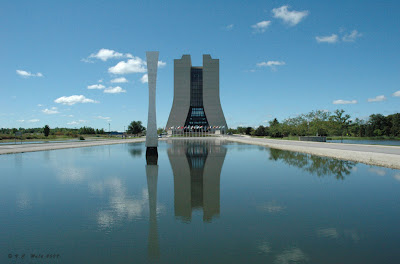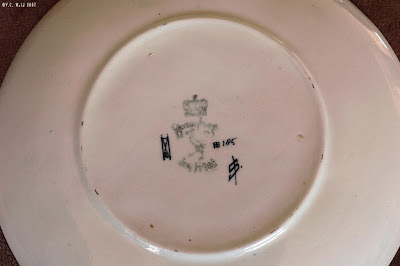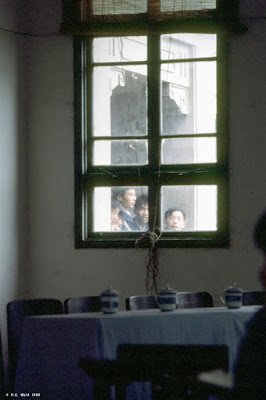
Last Sunday was among the top few gorgeous days of the summer, with cool breezes, ultra-blue skies punctuated by fluffywhites (you know what I mean), and very low humidity. KLK and I leapt enthusiastically (well, I was enthusiastic, KLK had to be tortured a bit) out of bed, rushed to get organized, hopped into the car, veered off course only to pick up sandwiches from the sultry, mumbling indentured servant behind the counter at our local Subway, and then headed straight past such suburban temptations as Oakbrook Mall, the Morton Arboretum, Cantigny without a sidewards glance, to Enrico Femi National Accelerator Laboratory in Batavia, Illinois. Fermilab to its friends, as we are. Please explore Fermi’s rich Web site. It’s high on my list of correctly-done Web sites and is full of information not only about what a high energy particle accelerator is and does, but also great detail about all of the goodies described below.
I had been there on a whatever-the-weather-opposite is, behind-the-scenes tour last fall. Because we had so much to keep us fascinated indoors, and because the weather was appalling, I never got farther outside of the main attraction than my parked car. But I was well aware that beyond the fog and pouring rain were:
 A stunning water feature reflecting the Robert Rathbun Wilson building,
A stunning water feature reflecting the Robert Rathbun Wilson building,named for Fermilab’s founding director, and Hyperbolic Obelisk, a sculpture he designed.
 It also has restored tall grass prairie and historically accurate fauna to eat it
It also has restored tall grass prairie and historically accurate fauna to eat it(My dear Yellowstone readers are especially strongly encouraged to follow the link)
 And cultivated acres. Boy, there’s not much as beautiful as mid-west farmland at the peak of summer!
And cultivated acres. Boy, there’s not much as beautiful as mid-west farmland at the peak of summer! And, at the end of a nicely graded gravel road, a glimpse into what it takes to keep the accelerator humming
And, at the end of a nicely graded gravel road, a glimpse into what it takes to keep the accelerator hummingThat turns out to be sculpture in its own right:

And water features. This one serves to help keep the Tevatron accelerator in the huge circular tunnel beneath cool, and to attract birds like herons, and amphibians for them to eat.
Note the wooded areas around the prairies, too.
Note the wooded areas around the prairies, too.

And yet more (Mobius Strip, Robert Wilson)
And there’s so very much more, impossible to fit in one blog. Maybe I’ll return to the subject, and the place, someday soon.




















